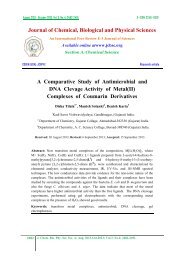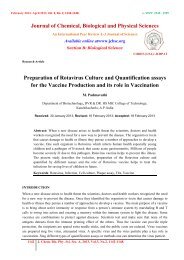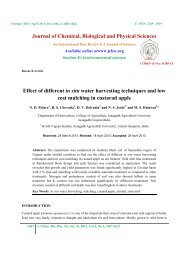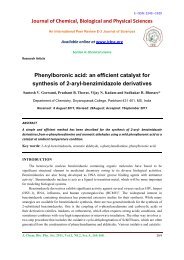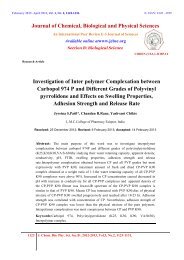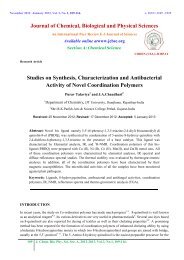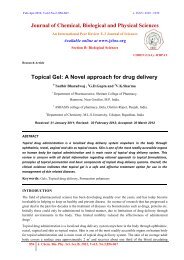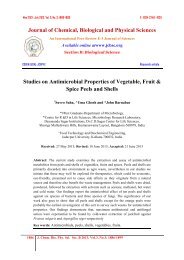Silica supported urea-hydrogen peroxide as a source of oxygen
Silica supported urea-hydrogen peroxide as a source of oxygen
Silica supported urea-hydrogen peroxide as a source of oxygen
- No tags were found...
Create successful ePaper yourself
Turn your PDF publications into a flip-book with our unique Google optimized e-Paper software.
<strong>Silica</strong>...Damandeep Kaur and B.R.Chabra.(determined iodometrically) in UHP adsorbed on silica gel (cf 36.2% in UHP adduct 8 without silica gel).Considering this fact the potential use <strong>of</strong> UHP- SiO 2 containing system for the allylic oxidation andepoxidation <strong>of</strong> some monoterpenes and sesquiterpenes containing different functionalities w<strong>as</strong>investigated. In this report, we examined the effect <strong>of</strong> UHP adsorbed on silica gel on the activity andselectivity in the oxidation reactions using tetrahydr<strong>of</strong>uran <strong>as</strong> a solvent and it h<strong>as</strong> been found that it is aninvaluable oxidising reagent.EXPERIMENTALMelting points reported are uncorrected. The IR spectra were recorded in CHCl 3 solution on a PerkinElmer model RX-1 FT-IR spectrophotometer and 1 H NMR spectra in CDCl 3 on Bruker AC 300 F (300MHz) NMR spectrometer (chemical shifts in δ, ppm) with TMS <strong>as</strong> internal standard. All thechromatographic separations were performed on silica gel.Extraction <strong>of</strong> starting compounds- Alantolides were obtained from the powdered roots <strong>of</strong> Inula racemosaby Soxhlet extraction method in hexane followed by refrigeration. The column chromatography <strong>of</strong> thesolidified material afforded pure alantolactone and isoalantolactone which were identified by comparison<strong>of</strong> their melting point and IR and 1 H NMR spectra with that <strong>of</strong> an authentic sample 10 . Dehydrocostuslactone w<strong>as</strong> obtained from the powdered roots <strong>of</strong> costus (Sauss<strong>urea</strong> lappa) by similar extractionprocedure.Preparation <strong>of</strong> UHP on silica gel: A solution <strong>of</strong> <strong>urea</strong> in 30% H 2 O 2 , in the molecular ratio 2:3 (12 g <strong>urea</strong>in 40 mL H 2 O 2 ) w<strong>as</strong> heated in a pyrex dish for a few minutes at temperature <strong>of</strong> about 60°C. This solutionw<strong>as</strong> then added to 50 g silica gel (60-120 mesh size). The mixture w<strong>as</strong> stirred for 30 min and dried underreduced pressure. The resulting free flowing powder w<strong>as</strong> then stored at room temperature.REACTION PROCEDUREAllylic oxidation: In a typical allylic oxidation reaction, isoalantolactone (3, 4.31 mmol, 1.0 g) w<strong>as</strong>dissolved in 20 ml tetrahydr<strong>of</strong>uran (THF) containing selenium dioxide (0.09 mmol, 10 mg). To this w<strong>as</strong>added 30 g <strong>of</strong> UHP-SiO 2 and the reaction mixture w<strong>as</strong> stirred at room temperature slowly. The reactionw<strong>as</strong> completed after 5 hrs stirring. The mixture w<strong>as</strong> filtered over a small bed <strong>of</strong> silica gel followed byw<strong>as</strong>hing with THF. The organic layer w<strong>as</strong> removed on rotary evaporator and extracted withdichloromethane (2 X 50 ml). The solvent w<strong>as</strong> evaporated in vacuo to furnish a crude product, which w<strong>as</strong>recrystallised to give a pure compound (4, 0.7 g). It showed mp 157° lit 9 mp 159-160°C. Similarly,geraniol (1) and dehydrocostus lactone (5) on allylic oxidation under similar conditions gave purecompounds (2) and (6, mp 140°C) respectively. The products obtained (Table 1) in this reaction weresimilar to those reported earlier. 6Epoxidation <strong>of</strong> olefins: Isoalantolactone (3, 4.31 mmol, 1.0 g) w<strong>as</strong> dissolved in 20 ml THF. To this w<strong>as</strong>added 30 g <strong>of</strong> UHP-SiO 2 and catalytic quantity <strong>of</strong> dodeca-phosphotungstic acid (H 3 [PW 12 O 40 ]xH 2 O). Thereaction mixture w<strong>as</strong> stirred at room temperature for 6 hrs. The mixture w<strong>as</strong> filtered over a small bed <strong>of</strong>silica gel followed by w<strong>as</strong>hing with THF. The organic layer w<strong>as</strong> removed on rotary evaporator andextracted with dichloromethane (2 X 50 ml). The solvent w<strong>as</strong> evaporated in vacuo to furnish a crudeproduct, which w<strong>as</strong> recrystallised to give a pure compound (7, 0.68 g). It showed mp 127° lit 10 mp126°C. Similarly, carvone (13) on treatment with UHP-SiO 2 and dodeca-phosphotungstic acid after usualwork up gave compound (14). It showed IR bands at 1660 and 1680 cm -1 confirming the presence <strong>of</strong> α,βunsaturatedsystem in 6- membered ring.Epoxidation <strong>of</strong> α,β- unsaturated ketones: To carvone (13, 0.5 ml) in THF (20 ml) w<strong>as</strong> added UHP-SiO 2 (5 g) followed by NaOH solution (10%, 5 ml). The reaction mixture w<strong>as</strong> kept at 4°C for 72 hrs. The981 J. Chem. Bio. Phy. Sci. Sec. A, 2013, Vol.3, No.2, 980-987.



